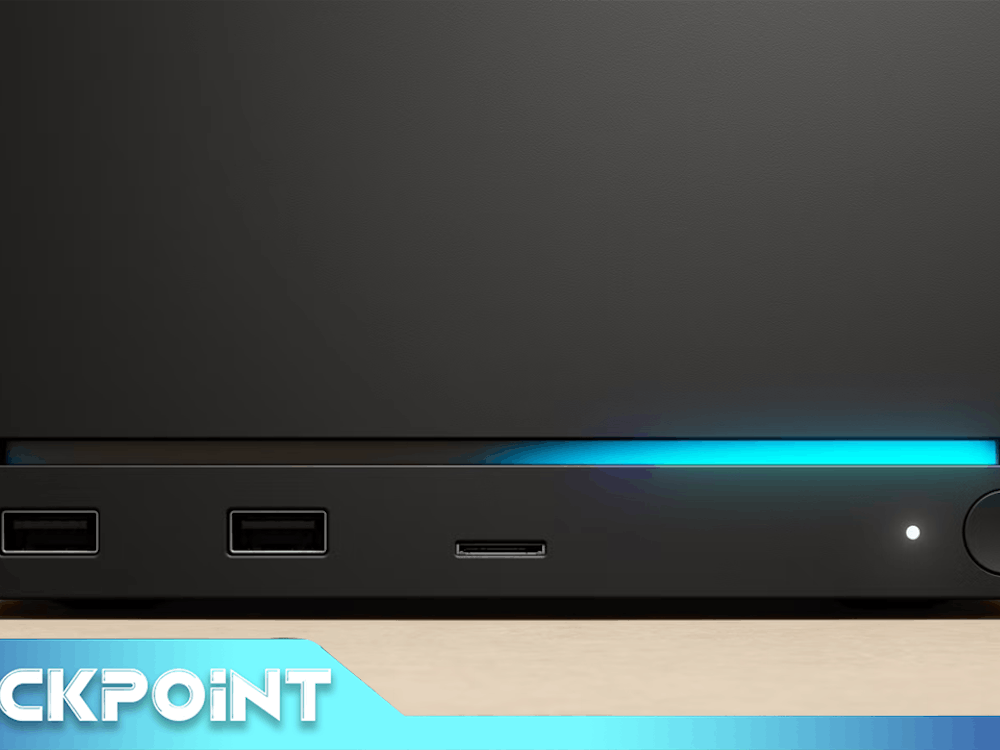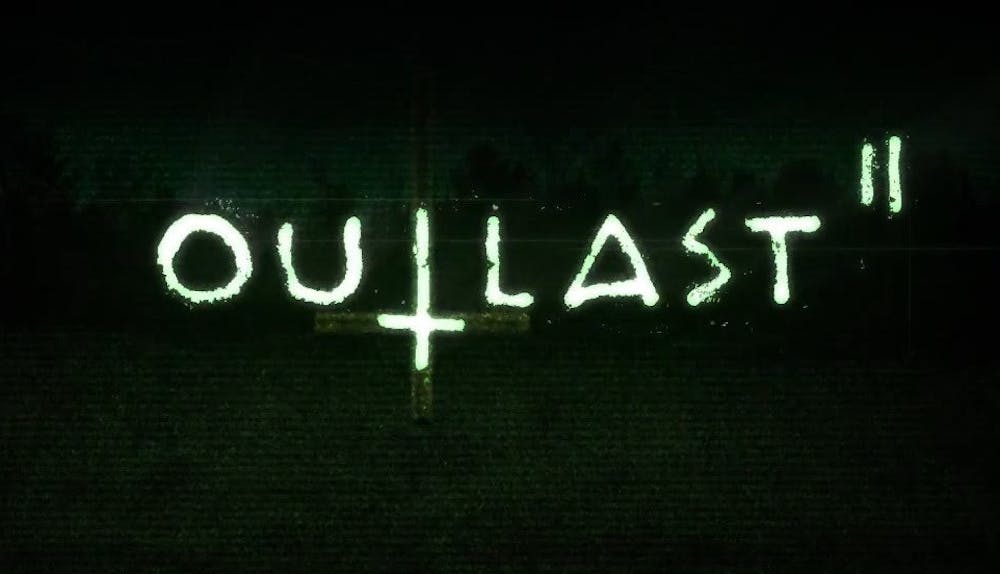by Emily Reuben Disclaimer: This playthrough was performed on an Intel i7-6700 with a GTX 1080 graphics card. This review is based on the PC version of the game. Outlast’s release in 2013 was met with immense praise; the dark environments, aggressive AI, and reliance on an infrared-equipped handheld camera have set Outlast apart from the hundreds of mediocre horror titles on Steam. Finally, the highly anticipated Outlast 2 has hit the market bringing with it new horrific imagery and themes reminiscent of the previous entry. While drawing influence from the original title, Outlast 2 manages to present plenty of new frights and more infinitely disturbing gameplay to keep players invested. However, Outlast 2 is far from a perfect title and can sometimes feel more like a repetitive drag than a shining example of the horror genre.
A wholly unholy narrative
Blake Langermann, a cameraman, and his wife Lynn, an investigative reporter, are documenting the murder of a young pregnant woman. While searching for where she came from, their helicopter crashes in the middle of a seemingly unpopulated reservation leaving the two injured and separated. After regaining consciousness, Blake finds the crucified body of the helicopter pilot, alluding to the ominous occurrences taking place throughout the game. Taking the role of Blake, players must use a camera to navigate the perilous landscape, find Lynn, and survive in the process. Survival is easier said than done in Outlast 2. After discovering the town of Temple Gate nearby, Blake quickly becomes aware that he and his missing wife are in danger. The town is run by a cult led by the radical Papa Knoth who convinces his followers that Lynn carries the Anti-Christ inside of her. Blake must overcome the violent towns people to save himself and Lynn before they become victims of the cult’s sacrificial practices.
The plot of Outlast 2 obviously draws inspiration from Outlast. In both iterations, the protagonist is trapped in an environment where everyone wants to kill them. While similar, there are enough differences to keep Outlast 2 fresh and distinct from its predecessor. Where Outlast 2 falls short is its inclusion of sequences that delve into Blake’s psyche and explore his personal demons. These sequences are more intrusive than they are scary and ultimately distract from the main plot.
Outlast 2 features a relatively strong narrative (especially when compared to most horror games) that fans of Outlast and newcomers alike are sure to enjoy for the most part. While the game’s set-up is great, Outlast 2 has difficulty maintaining narrative quality throughout. This becomes incredibly apparent in the ending, which for anyone who plays through the game, is a major disappointment. It seems like instead of creating a solid, satisfying conclusion for the narrative, the folks at Red Barrels decided to create an ending that would be talked about until they release the next DLC pack that will probably explain what actually happened.
Survival is easier said than done in Outlast 2. After discovering the town of Temple Gate nearby, Blake quickly becomes aware that he and his missing wife are in danger. The town is run by a cult led by the radical Papa Knoth who convinces his followers that Lynn carries the Anti-Christ inside of her. Blake must overcome the violent towns people to save himself and Lynn before they become victims of the cult’s sacrificial practices.
The plot of Outlast 2 obviously draws inspiration from Outlast. In both iterations, the protagonist is trapped in an environment where everyone wants to kill them. While similar, there are enough differences to keep Outlast 2 fresh and distinct from its predecessor. Where Outlast 2 falls short is its inclusion of sequences that delve into Blake’s psyche and explore his personal demons. These sequences are more intrusive than they are scary and ultimately distract from the main plot.
Outlast 2 features a relatively strong narrative (especially when compared to most horror games) that fans of Outlast and newcomers alike are sure to enjoy for the most part. While the game’s set-up is great, Outlast 2 has difficulty maintaining narrative quality throughout. This becomes incredibly apparent in the ending, which for anyone who plays through the game, is a major disappointment. It seems like instead of creating a solid, satisfying conclusion for the narrative, the folks at Red Barrels decided to create an ending that would be talked about until they release the next DLC pack that will probably explain what actually happened.
Updated graphics and frightening environments
this new entry does a far better job at varying the locations that the player must traverse through.Outlast 2 looks far better than its predecessor. The environments seem much larger and less confined with the exception of purposefully claustrophobic areas of the game. The villagers seen walking around have far more detail than the inmates in the first Outlast. It’s nice to see varied NPCs inhabiting the town rather than the same NPC model being used throughout the whole game. While there are instances of repeated character models, they usually occur in the form of a group of pursuing mutilated humans lending a more believable feel to the game. The designs of the villagers are both unsettling and varied which helps to create a dreadful experience when they begin to pursue Blake. The game should be commended for the dark, eerie environments it has established. Outlast also succeeded in this regard, but this new entry does a far better job at varying the locations that the player must traverse through. Environments still tend to become a bit indistinguishable at some points, and while annoying to some extent, this seems to be a purposeful choice to induce stress for the player rather than the result of lazy or clumsy game design.. As stated previously, Outlast 2 feels much larger than Outlast, as is showcased with the inclusion of more hidden areas to obtain batteries and bandages. The map is not necessarily huge, but there is definitely more to explore and discover. Returning from the first game are notes that give players more insight into the world and occurrences around them. These are largely optional, so players can choose whether or not they wish to take a break from running around in the dark to read journal entries. These journals are essential to finding out the backstory of Papa Knoth and the people of Temple Gate, as well as gaining insight into Blake’s tormented past.
Scary in some ways, lacking in others
Outlast 2 does not rely heavily on cheap jump scares or overused genre tropes to convey a chilling narrative. The fear certainly stems from scary imagery and unsettling environment construction, but the truly horrifying aspects of Outlast 2 are a result of the religious commentary and themes present throughout the game. The game does not shy away from controversial ideologies being presented. It clearly showcases some of the possible effects of religious indoctrination in both children and adults, thus calling into question religious morality. Outlast 2 constantly showcases the negative effects of religious brainwashing, yet the game never feels preachy or heavy-handed in its message. Instead the game shows what can happen when a trusted religious figure abuses their power over others. While these religious themes and criticisms are certainly present, there is no blatant stance being made pushing players to change stances or a call to action of any sort. Instead, the game merely showcases possibilities for players to further contemplate if they so choose. The critical religious portrayals offer some of the most interesting and scary elements of the game. Where Outlast 2 begins to falter is it’s excessive inclusion of psychological elements. At first, the narrative retained focus on the seemingly real situation surrounding Blake and his wife; they are trapped in a town of lunatic cultists who want to kill them. This should be enough to hold audience attention, but alas the game attempts to throw in elements of psychological horror in conjunction with the horrors plaguing Blake and his wife. It is important to note that horror is subjective; what one may find scary may be different than what others find scary. However, in terms of gameplay consistency the psychological segments, while scary enough in their own right, detract from the gravity of the situation by offering constant breaks for the player to escape from their murderous pursuers. These sequences often follow high stress situations and allow players a chance to relax briefly or gather more information regarding Blake’s past. This is the issue though: Blake’s past seems largely unimportant throughout the game and distracts from the story at hand. The reason these scenes taking place in Blake’s mind come off as unimportant is because they are never connected to the main plot of escaping Temple Gate. Had these segments been downplayed and the game stayed more focused on the actual situation at hand rather than Blake’s personal issues or if the two narratives had been connected more substantially, Outlast 2 would have succeeded in presenting a more realistic, gritty narrative.
The critical religious portrayals offer some of the most interesting and scary elements of the game. Where Outlast 2 begins to falter is it’s excessive inclusion of psychological elements. At first, the narrative retained focus on the seemingly real situation surrounding Blake and his wife; they are trapped in a town of lunatic cultists who want to kill them. This should be enough to hold audience attention, but alas the game attempts to throw in elements of psychological horror in conjunction with the horrors plaguing Blake and his wife. It is important to note that horror is subjective; what one may find scary may be different than what others find scary. However, in terms of gameplay consistency the psychological segments, while scary enough in their own right, detract from the gravity of the situation by offering constant breaks for the player to escape from their murderous pursuers. These sequences often follow high stress situations and allow players a chance to relax briefly or gather more information regarding Blake’s past. This is the issue though: Blake’s past seems largely unimportant throughout the game and distracts from the story at hand. The reason these scenes taking place in Blake’s mind come off as unimportant is because they are never connected to the main plot of escaping Temple Gate. Had these segments been downplayed and the game stayed more focused on the actual situation at hand rather than Blake’s personal issues or if the two narratives had been connected more substantially, Outlast 2 would have succeeded in presenting a more realistic, gritty narrative.
Gameplay is fun, but aggravating
The high stress chase sequences make a return from Outlast and function in largely the same manner. Players must run, crawl, climb, and hide to avoid capture and continue the game. A notable addition is the use of the camera’s microphone to gauge how close enemies are in relationship to Blake through audio levels. This is a great addition and serves to keep the player from dashing from a hiding place when the enemy is still in the vicinity. Overall, the controls work fabulously, but there are some crucial flaws that keep Outlast 2 from meeting the same quality standard as its predecessor. While the controls function rather well, navigating the landscape can be a real challenge. As stated above, environments can sometimes become repetitive making it difficult to determine which way to run while being chased down by an enemy. While there is some merit to adding this layer of difficulty to the game, it can quickly become tiring when an enemy repeatedly corners Blake in dead end or before the player can determine where some inconspicuous crawlspace is.
Lighting also adds to the game's difficulty. While this is by no means a massive issue due to the infrared option on Blake’s camera, navigating the darkness quickly becomes a strain on camera batteries and player patience. Another strain on player patience is the multitude of rocks and roots that Blake inexplicably becomes trapped on and unable to jump over. Getting snagged on these bits of level geometry completely breaks all tension, as the usual result is being killed and having to start the chase from the beginning. Similar to the small rocks and roots are the ankle high cactuses that lay in certain pathways. The spiky plant causes damage whenever touched, making certain areas a pain for Blake and the player to navigate in the unrelenting darkness.
All images from: Steam
While the controls function rather well, navigating the landscape can be a real challenge. As stated above, environments can sometimes become repetitive making it difficult to determine which way to run while being chased down by an enemy. While there is some merit to adding this layer of difficulty to the game, it can quickly become tiring when an enemy repeatedly corners Blake in dead end or before the player can determine where some inconspicuous crawlspace is.
Lighting also adds to the game's difficulty. While this is by no means a massive issue due to the infrared option on Blake’s camera, navigating the darkness quickly becomes a strain on camera batteries and player patience. Another strain on player patience is the multitude of rocks and roots that Blake inexplicably becomes trapped on and unable to jump over. Getting snagged on these bits of level geometry completely breaks all tension, as the usual result is being killed and having to start the chase from the beginning. Similar to the small rocks and roots are the ankle high cactuses that lay in certain pathways. The spiky plant causes damage whenever touched, making certain areas a pain for Blake and the player to navigate in the unrelenting darkness.
All images from: Steam



















